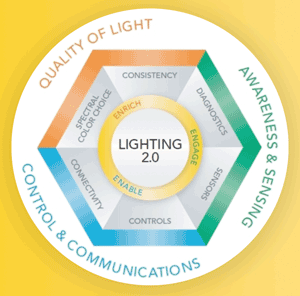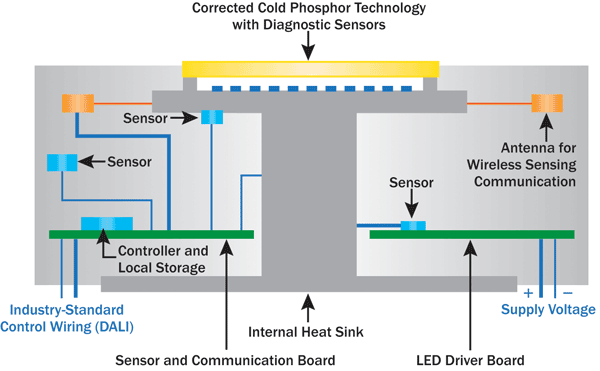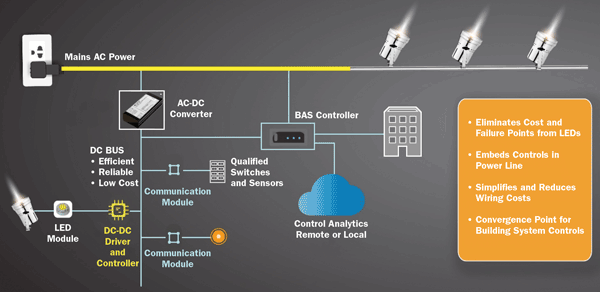Gerard Harbers, Xicato, and Sanjay Manney, Echelon Corp.
A network of LED lights can be controlled with new levels of ease and precision using commercially available intelligent lighting modules and control networking solutions.
The initial promise of LED lighting was to deliver more efficient lighting – not too hard a goal to reach considering that traditional incandescent and halogen lighting sources convert only five to 10 percent of energy consumed into light. But early LEDs did not provide light of a quality comparable to halogen or incandescent, and they were not bright enough for the A-lamp or PAR form factor. As a result, the LED industry focused on commercial outdoor lighting applications such as street lighting, where efficiency and maintenance outweighed light quality as the main drivers for success. This first foray into the world of illumination with white LEDs became known as LED Lighting 1.0: efficient (but not necessarily beautiful) light.
Now, however, improvements in both the efficiency and quality of LED lighting promise to make the light in our ceilings more than simply functional illumination. This is Lighting 2.0: efficient, high-quality lighting that can communicate and interact with its environment, as well as with the users that it serves.
The three essential components of Lighting 2.0 are quality of light, control and communications, and awareness and sensing. High-quality light is required to enrich an environment and make it feel welcoming. As with fluorescent lighting, quality of light trumps efficiency for adoption in retail and hospitality environments. Awareness and sensing allow people to engage with one another and the lit environment within a space. Control and communications capabilities help maximize ownership value and minimize costs.

The three essential components of Lighting 2.0 are quality of light, control and communications, and awareness and sensing.
Just as smartphones evolved from wired single-purpose analog devices into all-encompassing mobile digital platforms, Lighting 2.0 is transforming our fundamental relationship with lighting. And just as smartphones have become gateways to the Internet of Things, products based on Lighting 2.0 technologies and principles will also enable the Industrial Internet of Things (IIoT) in professionally lit spaces.
The intelligent module
Smart lighting, particularly for indoor spaces, encompasses aesthetic requirements for both luminaire and quality of light, plus practical operating and management parameters including space, wiring, provisioning and maintenance. In a retail or hospitality environment, for example, there are multiple luminaires of different styles and from different manufacturers, including track lights, recessed lights, sconces, pendants and other formats. The fixtures all need to look good, and the light emitted should be of uniform quality.
Indoor smart lighting requires a light engine that can be shared among a range of fixtures to ensure uniform light quality, functionality and performance throughout a space. Because luminaire space is at a premium, smart lighting has followed the consumer electronics industry’s approach of “smaller, better, faster, cheaper” to integrate control, communications, and drive and sensor components and technologies within a single small module. This module can then be applied universally to a broad range of luminaire designs and formats.
The result is the intelligent module, which integrates the following:
• Light source.
• Constant-voltage power supply using an integrated DC-DC LED driver with dimming capability.
• Integrated thermal and electrical sensors.
The intelligent module also incorporates wired or wireless communications and Bluetooth LE or similar for hyperlocal communications.
Figure 1 shows the components of the intelligent module, which becomes the foundation for building the Internet of Lights and connecting to the Industrial Internet of Things.

Figure 1. The components of the intelligent module.
The Industrial Internet of Things
The IIoT, at its simplest, can be defined as the integration of physical assets (machines, buildings, etc.) with sensors, control networks and intelligent software. The value propositions of the IIoT are analytics, remote access and management, collaboration, speed and accuracy of intelligence, and the easy capture and transfer of knowledge, not just data.
The IIoT is much more demanding than the consumer or human Internet of Things, which is characterized by applications and functions that involve human interaction such as wearable fitness trackers or home thermostats. The more stringent requirements of the IIoT include:
• Autonomous control, or the ability to operate without human intervention – either because the industrial environment is somehow inappropriate for people or because actions must take place too quickly, frequently or reliably to be handled by people.
• Peer-to-peer operation, without interaction with an Internet server or cloud.
• Industrial-strength reliability and industrial-grade security.
• Support for wired as well as wireless connectivity.
Internet of Lights meets the Internet of Things
An Internet of Lights is formed when all the smart lights in a space are connected by digital networks and are able to communicate with each other, communicate with a server or gateway, and communicate with sensors and controls in proximity of the lights. In such a configuration, the Internet of Lights becomes the backbone of a building-management or home-automation network. What makes this really attractive is that lights are virtually everywhere, and they already have (electrical) power to the light itself. This power can be used to run other electronic components and devices integrated into, or attached to, the networked lights.
The Internet of Lights is enabled by the success of LEDs in lighting. Traditionally, it was hard to integrate electronics into lights because of high temperature, electromagnetic interference and limited bulb life. LEDs are themselves semiconductor components, running at low temperature – typically at about the same temperature range as many of the other power semiconductor devices used in electronics. It is therefore easy to integrate additional functions into LED modules. Further, almost all the electronic components used for communication, control and sensors are also low-voltage components that can share the same power supply, reducing the component count and costs.
One way to form an Internet of Lights is to use power-line communication over a low-voltage (DC) power grid, as demonstrated in Figure 2.

Figure 2. Using power-line communication over a low-voltage (DC) power grid can form an Internet of Lights, as seen in this indoor-lighting demo by Echelon and Xicato. The demo shows DC distribution per room (not per LED). BAS = Building automation systems.
In this solution, all the lights and other electronic devices in an area are powered from a single 48-V DC power supply, which in turn is powered by either a traditional AC mains power line or higher-voltage DC (380 V) distribution systems such as those used in data centers. Especially attractive is the combination of DC power grids with solar energy collection: Why not power the lights in offices and retail spaces directly via sunlight without going through the inefficient and costly DC-AC and AC-DC conversion systems used today?
The choice of 48 V for the power system is important, too. It’s the voltage level already used in power-over-Ethernet applications and is the standard for traditional phone systems. The benefits of 48 V are the following:
• It is low enough to protect against electrical shock without using conduits or special cabling.
• Compared with lower voltages (such as 12 and 24 V), it can supply sufficient power to the lights, sensors and controls without requiring thick wires.
• Transmission losses are minimized.
In the demo, a LonWorks-based network uses the LonTalk protocol to establish peer-to-peer connections enabling robust and reliable operation of the Internet of Lights network – even in the absence of connection to the server. A SmartServer acts as a gateway to enterprise servers (cloud-based or local) and manages the network. Control and communication are performed over the same wires that carry power.
The communication between the lights and the other devices in the network focuses on light control and operational data from the lights themselves. The lights can be controlled through a client (a PC) and by LonTalk switches on the 48-V DC network, and the operational data can be read through the server and presented on the client. The operational data from the lights consists of actual run-time data from the intelligent module (how many hours it has been running), temperatures of various components in the light module, temperature run-time history (run time at different temperatures), and electrical characteristics of the power supply and the LED load. This data can be used similarly to an odometer and the check-engine light in a car to estimate the remaining lifetime of the light, or to indicate to the building-management systems that something is wrong well before a light goes out. This forewarning allows building managers to perform lighting maintenance in a structured and timely fashion.
Sensors and controls can be directly attached to the lights and the Internet of Lights network, or can also be incorporated via short-range wireless connectivity options, such as 6LoWPAN or Bluetooth Smart radios. In this way, the lights become access points for the Internet of Things, where the “things” could have short-range wireless radios with very long battery life due to the proximity of the access points. Because the radios in the lights are connected to the electrical grid, the radios are always on and listening for devices, and able to locate them as long as the physical location of the lights in the building is known.
Opportunities created
As individual lights become smarter and then are networked together and connected to additional sensors, actuators and other devices – i.e., as the Internet of Lights meets the Internet of Things – a new world of opportunities is created.
The most obvious area of opportunity is in retail and hospitality applications, where the quality of light casts the products on display in their best colors, textures and appeal. Software control of the lit environment can highlight specific physical areas to draw more attention. Intelligent sensing and controls can monitor customer behavior, allowing the use of instant-gratification promotions to increase sales and customer satisfaction.
Data on traffic patterns and facility usage that is gathered from sensors can optimize product placement.
In addition, measured data can be made available for intelligent analytics to uncover trends that were previously hidden. Perhaps the greatest potential comes from the unification of building-management information through lighting, which is the most ubiquitous functional element in a space, and the subsequent provisioning of new platforms for which a wide variety of applications can be developed. In this way, the intersection of the Internet of Lights and the Internet of Things creates a boon for the software industry at large.
Reactions, conclusions
The Internet of Lights – enabled by an intelligent light module with a combination of light quality, control and communications, and awareness and sensing capabilities – finally provides a viable value proposition for wide-scale deployment of LED lights in indoor environments. As intelligent modules enable the Internet of Lights, and as the Internet of Lights meets the Industrial Internet of Things, the resulting interconnectedness and intercommunication, under intelligent digital control, will give rise to new classes of applications and devices that will improve sales, productivity, customer satisfaction, safety and quality of life.
Better illumination, lighting control and energy efficiency are no longer future promises. This working demonstration shows how a network of LED lights can be controlled with new levels of ease and precision using commercially available intelligent lighting modules and control networking solutions.
Meet the authors
Gerard Harbers is chief technology officer and a co-founder of Xicato in San Jose, Calif.; email: [email protected]. Sanjay Manney is the director of product management for the Internet of Things at Echelon Corp. in San Jose, Calif.; email: [email protected].